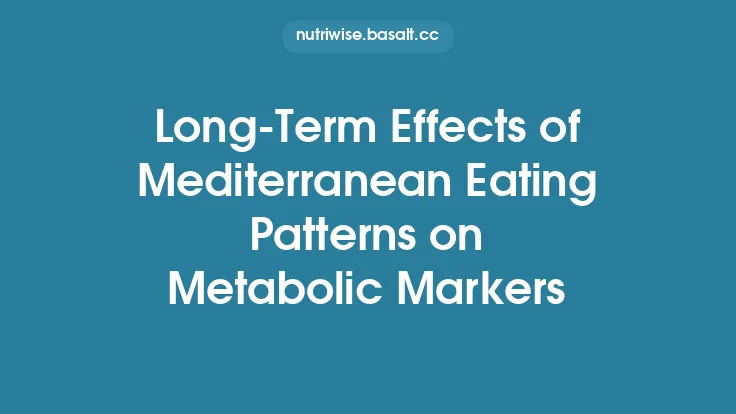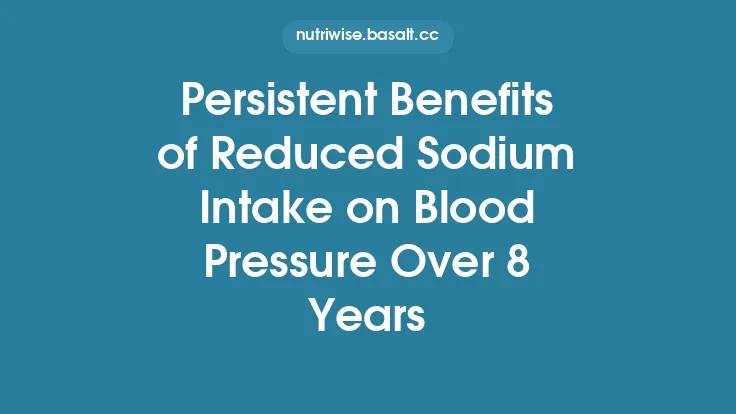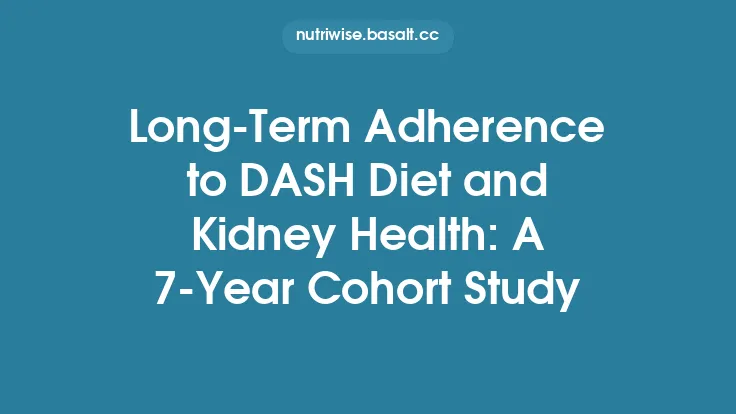Sodium consumption remains a pivotal factor in the global burden of cardiovascular disease, hypertension, and renal disorders. While short‑term surveys provide snapshots of intake, only sustained, longitudinal surveillance can reveal true shifts in population behavior, the impact of policy measures, and emerging risk patterns. This article outlines the foundational concepts, methodological toolbox, analytical strategies, and practical considerations essential for establishing and maintaining long‑term tracking of sodium intake across diverse populations. By focusing on evergreen principles rather than time‑bound findings, the discussion equips researchers, public health agencies, and policymakers with a durable framework for sodium surveillance that can be adapted to any setting and updated as new data become available.
The Rationale for Ongoing Sodium Surveillance
- Health Impact: Excess sodium is directly linked to elevated blood pressure, a leading modifiable risk factor for stroke and heart disease. Quantifying intake over time allows health systems to gauge the effectiveness of sodium‑reduction initiatives.
- Policy Evaluation: Many jurisdictions have introduced front‑of‑pack labeling, reformulation targets, or public‑education campaigns. Longitudinal data are the only robust metric for assessing whether such policies translate into measurable intake reductions.
- Equity Assessment: Persistent socioeconomic, geographic, and cultural differences in dietary patterns can be identified only through repeated measurements, enabling targeted interventions for high‑risk groups.
- Research Synergy: Continuous sodium data feed into epidemiological models, risk‑prediction tools, and cost‑effectiveness analyses, strengthening the evidence base for future guidelines.
Core Data Sources for Sodium Intake Monitoring
| Source | Strengths | Limitations | Typical Frequency |
|---|---|---|---|
| 24‑Hour Dietary Recalls (24HR) | Detailed food‑level data; captures discretionary salt use when paired with probing | Relies on participant memory; under‑reporting of salty snacks | Annually or biennially in large surveys |
| Food Frequency Questionnaires (FFQ) with Sodium Modules | Feasible for large cohorts; captures habitual intake | Less precise for absolute intake; limited for processed‑food sodium | Every 3–5 years in cohort studies |
| Household Food Supply Surveys | Objective measurement of purchased sodium; useful for monitoring reformulation | Does not account away‑from‑home consumption; may miss waste | Every 2–4 years |
| Urinary Sodium Excretion (Spot or 24‑Hour) | Gold‑standard biomarker reflecting total intake | 24‑hour collections are burdensome; spot samples need correction equations | Periodic subsamples (e.g., 5–10 % of population) |
| Retail Sales and Barcode Data | Real‑time monitoring of processed‑food sodium trends | Requires comprehensive product databases; cannot capture home‑cooked meals | Continuous, with quarterly aggregation |
| Digital Food‑Logging Platforms | High granularity; potential for real‑time analytics | User bias; limited to tech‑savvy participants | Ongoing, with periodic validation |
A robust surveillance system typically triangulates at least two of these sources, balancing precision (urinary biomarkers) with breadth (dietary recalls or FFQs).
Methodological Approaches to Estimate Sodium Intake
- Direct Biomarker Calibration
- Collect 24‑hour urine from a representative subsample.
- Use regression calibration to adjust self‑reported intake from recalls/FFQs, correcting systematic under‑reporting.
- Food Composition Database (FCDB) Alignment
- Ensure the sodium values in the FCDB reflect current product formulations.
- Update the database annually using manufacturer disclosures, national labeling regulations, and laboratory analyses.
- Discretionary Salt Quantification
- Incorporate probing questions about table salt and cooking practices.
- Apply conversion factors derived from observational studies (e.g., average grams of salt added per household per day).
- Statistical Imputation for Missing Data
- Use multiple imputation with chained equations (MICE) to handle non‑response in urine collections or incomplete dietary records.
- Include auxiliary variables such as age, sex, BMI, and socioeconomic status to improve imputation accuracy.
- Standardization and Energy Adjustment
- Express sodium intake per 2 000 kcal to facilitate comparisons across populations with differing energy needs.
- Apply the residual method for energy adjustment when analyzing associations with health outcomes.
Longitudinal Analytical Techniques
- Mixed‑Effects Models
Capture within‑person changes over time while accounting for clustering at household or community levels. Random intercepts and slopes allow for heterogeneous trajectories.
- Joinpoint Regression
Detect points in time where the trend in sodium intake changes direction, useful for evaluating the impact of policy introductions.
- Age‑Period‑Cohort (APC) Decomposition
Separate the influence of aging, calendar period, and birth cohort on sodium consumption patterns, revealing generational shifts.
- Time‑Series Forecasting (ARIMA, Prophet)
Project future intake levels under different scenarios (e.g., continued reformulation vs. stagnation), informing strategic planning.
- Geospatial Trend Mapping
Combine longitudinal data with GIS to visualize regional trajectories, highlighting hotspots of high sodium intake.
Interpreting Trends: From Numbers to Actionable Insights
- Absolute vs. Relative Change
Report both the mean reduction in milligrams per day and the percentage change relative to baseline, providing context for public‑health relevance.
- Benchmarking Against Recommendations
Compare observed intakes with WHO’s <2 000 mg/day target, noting the proportion of the population meeting the guideline over time.
- Subgroup Analyses
Disaggregate trends by age, sex, income, urbanicity, and ethnicity to uncover inequities. For instance, a modest national decline may mask rising intake among low‑income urban dwellers.
- Linkage to Health Outcomes
Align sodium trend data with hypertension prevalence or cardiovascular event rates in the same surveillance cycles to assess temporal concordance.
Public Health Implications of Long‑Term Sodium Data
- Policy Refinement
Evidence of plateauing reductions can trigger stricter reformulation targets or expanded labeling mandates.
- Program Targeting
Identified high‑intake clusters become priority zones for community‑based education, cooking workshops, or subsidized low‑sodium products.
- Resource Allocation
Surveillance outcomes guide funding decisions, ensuring that monitoring resources are concentrated where they yield the greatest health benefit.
- International Comparability
Standardized methodologies enable cross‑country benchmarking, fostering collaborative efforts to meet global sodium reduction goals.
Common Challenges and Mitigation Strategies
| Challenge | Mitigation |
|---|---|
| Participant Burden (24‑hr urine) | Use passive collection devices; provide incentives; limit to a rotating subsample |
| Rapid Food‑Product Reformulation | Establish real‑time data feeds from manufacturers; conduct periodic market basket analyses |
| Under‑reporting of Discretionary Salt | Incorporate objective measures (e.g., salt‑meter devices) in a subsample; apply correction factors |
| Data Integration Across Sources | Develop a centralized data warehouse with standardized variable definitions and metadata |
| Funding Sustainability | Embed sodium surveillance within broader nutrition monitoring platforms to share costs |
Integrating Sodium Surveillance with Policy and Intervention Frameworks
- Feedback Loops
- Publish interim surveillance briefs for policymakers within 6 months of data collection.
- Use these briefs to adjust ongoing interventions (e.g., intensify media campaigns if intake rises).
- Regulatory Alignment
- Align surveillance metrics with regulatory thresholds (e.g., maximum sodium per 100 g for processed foods).
- Provide compliance dashboards to food industry stakeholders.
- Community Engagement
- Involve local health workers in data collection and dissemination, fostering trust and improving response rates.
- Co‑design educational materials based on identified high‑intake foods in each community.
- Evaluation Frameworks
- Apply the RE-AIM (Reach, Effectiveness, Adoption, Implementation, Maintenance) model to assess the impact of sodium‑reduction policies, using surveillance data as the effectiveness metric.
Future Directions and Emerging Technologies
- Wearable Sodium Sensors
Prototype devices measuring sweat sodium could complement urinary biomarkers, offering continuous, non‑invasive monitoring.
- Machine‑Learning‑Enhanced Food Composition Updates
Natural‑language processing of product labels and ingredient lists can automate FCDB revisions, keeping sodium values current.
- Crowdsourced Dietary Reporting Apps
Leveraging large user bases to capture real‑time intake, with built‑in validation studies to calibrate against biomarker data.
- Synthetic Population Modeling
Generate virtual cohorts that reflect observed sodium distributions, enabling scenario testing without additional data collection.
- Integration with Electronic Health Records (EHRs)
Link sodium intake estimates to clinical data (blood pressure, medication use) for precision public‑health interventions.
Concluding Perspective
Long‑term tracking of sodium intake is more than a statistical exercise; it is a cornerstone of evidence‑based nutrition policy and chronic disease prevention. By combining rigorous biomarker validation, comprehensive dietary assessment, sophisticated longitudinal analytics, and a clear pathway to policy action, surveillance systems can deliver the evergreen insights needed to sustain progress toward global sodium‑reduction targets. Continuous refinement, interdisciplinary collaboration, and the adoption of emerging technologies will ensure that sodium surveillance remains responsive, accurate, and impactful for generations to come.





